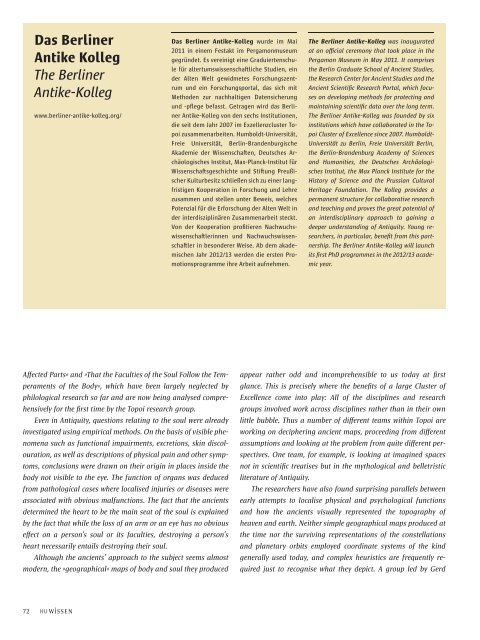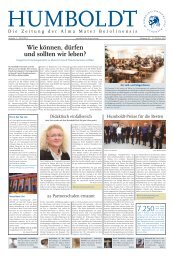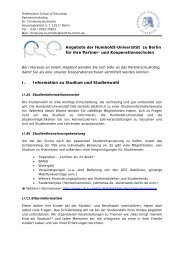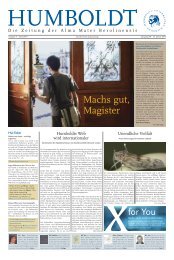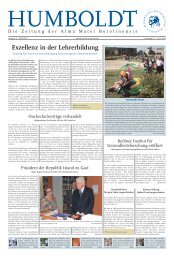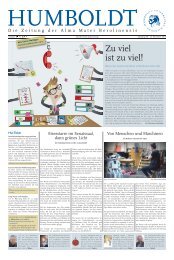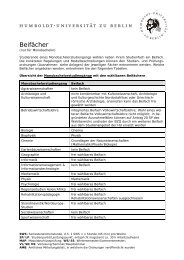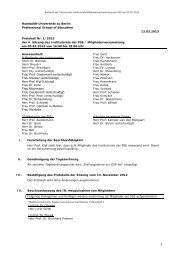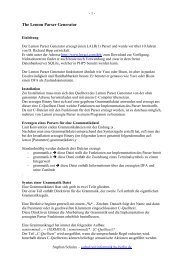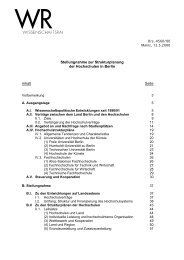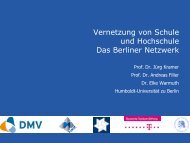hu wissen 3 (pdf) - Humboldt-Universität zu Berlin
hu wissen 3 (pdf) - Humboldt-Universität zu Berlin
hu wissen 3 (pdf) - Humboldt-Universität zu Berlin
Erfolgreiche ePaper selbst erstellen
Machen Sie aus Ihren PDF Publikationen ein blätterbares Flipbook mit unserer einzigartigen Google optimierten e-Paper Software.
Das <strong>Berlin</strong>er<br />
Antike Kolleg<br />
The <strong>Berlin</strong>er<br />
Antike-Kolleg<br />
www.berliner-antike-kolleg.org/<br />
Das <strong>Berlin</strong>er Antike-Kolleg wurde im Mai<br />
2011 in einem Festakt im Pergamonmuseum<br />
gegründet. Es vereinigt eine Graduiertensc<strong>hu</strong>le<br />
für altertums<strong>wissen</strong>schaliche Studien, ein<br />
der Alten Welt gewidmetes Forsc<strong>hu</strong>ngszentrum<br />
und ein Forsc<strong>hu</strong>ngsportal, das sich mit<br />
Methoden <strong>zu</strong>r nachhaltigen Datensicherung<br />
und -pflege befasst. Getragen wird das <strong>Berlin</strong>er<br />
Antike-Kolleg von den sechs Institutionen,<br />
die seit dem Jahr 2007 im Exzellenzcluster Topoi<br />
<strong>zu</strong>sammenarbeiten. <strong>Humboldt</strong>-Universität,<br />
Freie Universität, <strong>Berlin</strong>-Brandenburgische<br />
Akademie der Wissenschaen, Deutsches Archäologisches<br />
Institut, Max-Planck-Institut für<br />
Wissenschasgeschichte und Stiung Preußischer<br />
Kulturbesitz schließen sich <strong>zu</strong> einer langfristigen<br />
Kooperation in Forsc<strong>hu</strong>ng und Lehre<br />
<strong>zu</strong>sammen und stellen unter Beweis, welches<br />
Potenzial für die Erforsc<strong>hu</strong>ng der Alten Welt in<br />
der interdisziplinären Zusammenarbeit steckt.<br />
Von der Kooperation profi tieren Nachwuchs<strong>wissen</strong>schalerinnen<br />
und Nachwuchs<strong>wissen</strong>schaler<br />
in besonderer Weise. Ab dem akademischen<br />
Jahr 2012/13 werden die ersten Promotionsprogramme<br />
ihre Arbeit aufnehmen.<br />
The <strong>Berlin</strong>er Antike-Kolleg was inaugurated<br />
at an official ceremony that took place in the<br />
Pergamon Museum in May 2011. It comprises<br />
the <strong>Berlin</strong> Graduate School of Ancient Studies,<br />
the Research Center for Ancient Studies and the<br />
Ancient Scientific Research Portal, which focuses<br />
on developing methods for protecting and<br />
maintaining scientific data over the long term.<br />
The <strong>Berlin</strong>er Antike-Kolleg was founded by six<br />
institutions which have collaborated in the Topoi<br />
Cluster of Excellence since 2007. <strong>Humboldt</strong>-<br />
Universität <strong>zu</strong> <strong>Berlin</strong>, Freie Universität <strong>Berlin</strong>,<br />
the <strong>Berlin</strong>-Brandenburg Academy of Sciences<br />
and Humanities, the Deutsches Archäologisches<br />
Institut, the Max Planck Institute for the<br />
History of Science and the Prussian Cultural<br />
Heritage Foundation. The Kolleg provides a<br />
permanent structure for collaborative research<br />
and teaching and proves the great potential of<br />
an interdisciplinary approach to gaining a<br />
deeper understanding of Antiquity. Young researchers,<br />
in particular, benefit from this partnership.<br />
The <strong>Berlin</strong>er Antike-Kolleg will launch<br />
its first PhD programmes in the 2012/13 academic<br />
year.<br />
Affected Parts« and »That the Faculties of the Soul Follow the Temperaments<br />
of the Body«, which have been largely neglected by<br />
philological research so far and are now being analysed comprehensively<br />
for the first time by the Topoi research group.<br />
Even in Antiquity, questions relating to the soul were already<br />
investigated using empirical methods. On the basis of visible phenomena<br />
such as functional impairments, excretions, skin discolouration,<br />
as well as descriptions of physical pain and other symptoms,<br />
conclusions were drawn on their origin in places inside the<br />
body not visible to the eye. The function of organs was deduced<br />
from pathological cases where localised injuries or diseases were<br />
associated with obvious malfunctions. The fact that the ancients<br />
determined the heart to be the main seat of the soul is explained<br />
by the fact that while the loss of an arm or an eye has no obvious<br />
effect on a person’s soul or its faculties, destroying a person’s<br />
heart necessarily entails destroying their soul.<br />
Although the ancients’ approach to the subject seems almost<br />
modern, the »geographical« maps of body and soul they produced<br />
appear rather odd and incomprehensible to us today at first<br />
glance. This is precisely where the benefits of a large Cluster of<br />
Excellence come into play: All of the disciplines and research<br />
groups involved work across disciplines rather than in their own<br />
little bubble. T<strong>hu</strong>s a number of different teams within Topoi are<br />
working on deciphering ancient maps, proceeding from different<br />
assumptions and looking at the problem from quite different perspectives.<br />
One team, for example, is looking at imagined spaces<br />
not in scientific treatises but in the mythological and belletristic<br />
literature of Antiquity.<br />
The researchers have also found surprising parallels between<br />
early attempts to localise physical and psychological functions<br />
and how the ancients visually represented the topography of<br />
heaven and earth. Neither simple geographical maps produced at<br />
the time nor the surviving representations of the constellations<br />
and planetary orbits employed coordinate systems of the kind<br />
generally used today, and complex heuristics are frequently required<br />
just to recognise what they depict. A group led by Gerd<br />
72


